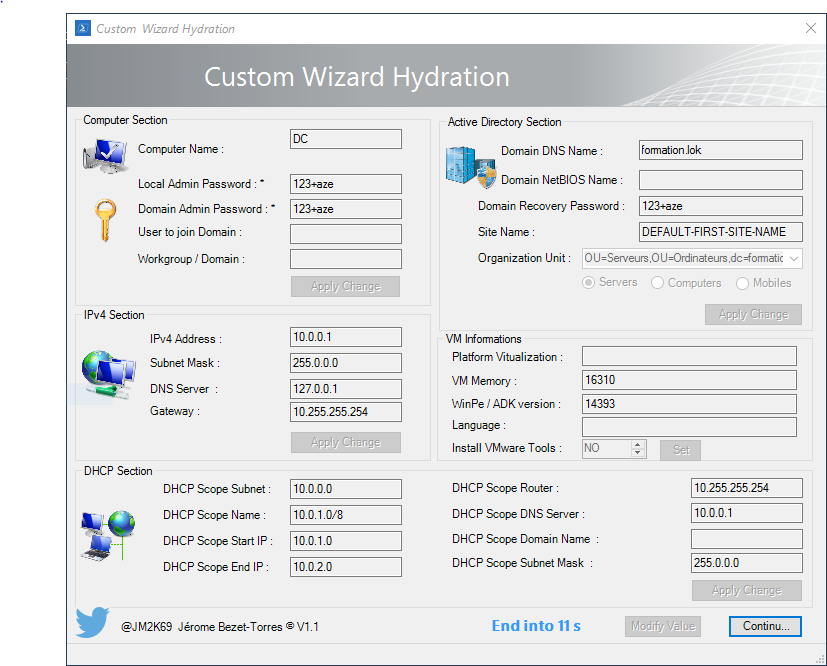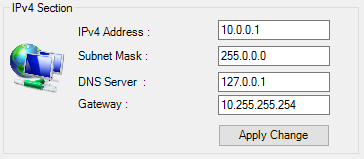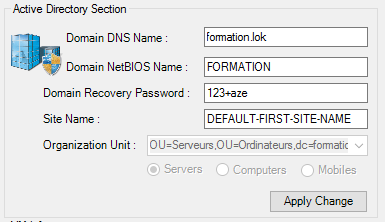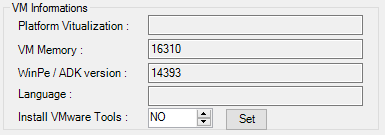Custom Wizard Hydration for HydrationKit - Part1
Today, to automate or customize products we are forced to use scripts, I wish I could wish customize the Hydration Kit for SCCM and other products. That is why I have decided to create a GUI in PowerShell to interact with all of the files of configurations that offers us MDT when using offline media. So i use PowerShell 2017 Studio to create this GUI.
What can I customize ?
With Custom Hydration you can customize :
Script interface
1. Computers Section
- Computer Name
- Local Admin Password
- Domain Admin Password for domain controller only
- Worgroup or Domain
2. Network Section @IPV4
- IPv4 Address
- Subnet Mask
- DNS Server
- Gateway
3. DHCP Section
- DHCP scope subnet
- DHCP scope name
- DHCP scope start IPv4
- DHCP scope end IPv4
- DHCP scope router
- DHCP scope DNS server
- DHCP scope domain name
- DHCP scope subnet mask
4. Active Directory Section for Domain Controller
- Domain DNS name
- Domain NetBios name
- Domain recovery password
- Site name
- Organizational Unit
5. Informations only
- Platform Virtualization
- VM memory
- WinPe / ADK version
- Language
- Install VMware Tools
All these values are stored in variables that result from running the ZTIGather.wsf script, then its values are stored in memory and in the VARIABLES.DAT file.
Customsetting.ini
The customsettings.ini file contains all the necessary rules and all the information for a task sequence. Therefore, modify the customsettings.ini file so that the CWH.ps1 script to work properly.
Sample Customsetting.ini
[Settings]
Priority=Default
Properties=HydrationOSDComputerName,HydraTimerSec,VMTOOLS
[Default]
HydraTimerSec = 20
VMTOOLS=NO
HydrationOSDComputerName=DC01
The HydraTimerSec Property corresponds to the time from which we have the opportunity to press the modify button. The property VMTOOLS is if you run the Hydration Kit in VMware products like vSphere or Workstation it install VMware Tools during the TaskSequence.
TaskSequences
For each virtual machine, there is an INI file that populates the machine-specific information, they are located in the Deploy\Control\ directory of the DVD or USB bootable they are named in the following way :
*CustomSettings_“ID Tasksequence“.ini
Now in the Hydration Kit all applications must be accept by default all domain and it will be available for all OS Culture (Fr - EN….). Nowadays it works only for French OS Culture. I found a way to find OS Culture during the OSD. I wrote this Function :
function Get-OsCulture
{
[CmdletBinding()]
param ()
$oscode = Get-WmiObject Win32_OperatingSystem -ComputerName localhost -ErrorAction continue | foreach { $_.oslanguage }
$Culture =switch ($oscode) `
{
1033 { "English" };
1036 { "French" };
default { "Unknown" }
}
switch ($Culture)
{
'French'{
$AdminAccount = "Administrateur"
$AdminGroupsAccount = "Administrateurs"
$AdminDomaintGroupsAccount= "Admins du domaine"
return $AdminAccount,$AdminGroupsAccount,$AdminDomaintGroupsAccount
}
{'English'}{
$AdminAccount = "Administrator"
$AdminGroupsAccount = "Administrators"
$AdminDomaintGroupsAccount = "Domain Admins"
return $AdminAccount,$AdminGroupsAccount,$AdminDomaintGroupsAccount
}
Default {}
}
}
# Use varaibles to get AD account groups
$AdminAccount=(Get-OsCulture)[0]
$AdminGroupsAccount = (Get-OsCulture)[1]
$AdminDomaintGroupsAccount = (Get-OsCulture)[2]
Applications
All Applications or wrapper used PowerShell.
One Example
Here the code for the PowerShell Application Configure - Create AD Structure. Actually the script doesn’t use the Get-OsCulture.
<#
Solution HydrationKit
Action : Configure - AD Structure
Created: 2016-02-1
Version: 1.0
This script is provided "AS IS" with no warranties, confers no rights and
is not supported by the author.
Author - Jérôme Bezet-Torres
Twitter: @JM2K69
#>
# Determine where to do the logging
$tsenv = New-Object -COMObject Microsoft.SMS.TSEnvironment
$logPath = $tsenv.Value("LogPath")
$logFile = "$logPath\$($myInvocation.MyCommand).log"
# Start the logging
Start-Transcript $logFile
Write-Host "Logging to $logFile"
#Get ADDS DOMAIN Info
$info = get-addomain
$infoC = $info.DNSRoot
function get-DN ($param1)
{
$Rdomain = ""
$split = $param1.split(".")
$nb = $split.Count
switch ($nb)
{
2{
$domain1 = $split[0]
$Ext1 = $split[1]
$Rdomain = "dc=$domain1,dc=$ext1"
return $Rdomain
}
3{
$sdomain = $split[0]
$domain = $split[1]
$Ext = $split[2]
$Rdomain = "dc=$sdomain,dc=$domain,dc=$ext"
return $Rdomain
}
}
}
$dom = get-DN $infoC
# Décalaration des variables
$1niveau = @("Matériels", "Utilisateurs", "Ordinateurs")
$Users = $1niveau[1]
$ordi = $1niveau[2]
$Services = @("Marketing", "Informatique", "Direction", "Comptabilité", "Production", "Comptes_services")
$Groupes = @("Groupes_DL", "Groupes_GL", "Groupes_U")
$Type = @("Fixes", "Portables", "Serveurs")
#Création des Ou de 1 er Niveaux Matériels, Utilisateurs, Ordinateurs
Foreach ($x in $1niveau) { New-ADOrganizationalUnit -Name $x -ProtectedFromAccidentalDeletion $false }
#Création des Ou sous Utilisteurs
New-ADOrganizationalUnit -Name "Services" -path "ou=$Users,$dom" -ProtectedFromAccidentalDeletion $false
Foreach ($x in $Services) { New-ADOrganizationalUnit -Name $x -path "ou=Services,ou=$Users,$dom" -ProtectedFromAccidentalDeletion $false }
New-ADOrganizationalUnit -Name "Groupes" -path "ou=$Users,$dom" -ProtectedFromAccidentalDeletion $false
Foreach ($x in $Groupes) { New-ADOrganizationalUnit -Name $x -path "ou=Groupes,ou=$Users,$dom" -ProtectedFromAccidentalDeletion $false }
#Création des Ou sous Ordinateurs
Foreach ($x in $Type) { New-ADOrganizationalUnit -Name $x -path "ou=$ordi,$dom" -ProtectedFromAccidentalDeletion $false }
New-ADGroup -DisplayName "G_Informatique" -GroupScope Global -Name "G_Informatique" -Path "OU=Groupes_GL,OU=Groupes,OU=Utilisateurs,$dom"
New-ADGroup -DisplayName "G_Marketing" -GroupScope Global -Name "G_Marketing" -Path "OU=Groupes_GL,OU=Groupes,OU=Utilisateurs,$dom"
New-ADGroup -DisplayName "G_Comptabilité" -GroupScope Global -Name "G_Comptabilité" -Path "OU=Groupes_GL,OU=Groupes,OU=Utilisateurs,$dom"
New-ADGroup -DisplayName "G_Directions" -GroupScope Global -Name "G_Directions" -Path "OU=Groupes_GL,OU=Groupes,OU=Utilisateurs,$dom"
New-ADGroup -DisplayName "G_Tech Support" -GroupScope Global -Name "G_Tech Support" -Path "OU=Groupes_GL,OU=Groupes,OU=Utilisateurs,$dom"
New-ADGroup -DisplayName "G_MDT" -GroupScope Global -Name "G_MDT" -Path "OU=Groupes_GL,OU=Groupes,OU=Utilisateurs,$dom"
New-ADGroup -DisplayName "G_SysCenterSuite" -GroupScope Global -Name "G_SysCenterSuite" -Path "OU=Groupes_GL,OU=Groupes,OU=Utilisateurs,$dom"
$Informatiques = @("Julien", "Laurent", "Jerome", "Fabien")
$Password = "123+aze"
$ou = "OU=Informatique,ou=Services,ou=$Users,$dom"
foreach ($p in $Informatiques)
{
New-ADUser -Name $p -GivenName $p -DisplayName "$p" -SamAccountName $p -Path $OU -PasswordNeverExpires 1 -Description "Administrateurs"
Set-ADAccountPassword -Identity $p -NewPassword (ConvertTo-SecureString -AsPlainText $Password -Force)
Add-ADPrincipalGroupMembership -Identity $p -MemberOf "Administrateurs", "Admins du domaine", "G_Informatique"
Enable-ADAccount -Identity $p
}
$Marketing = @("Juliette", "Sylvie", "Anne", "Stéphane")
$Password = "123+aze"
$ou = "OU=Marketing,ou=Services,ou=$Users,$dom"
foreach ($p in $Marketing)
{
New-ADUser -Name $p -GivenName $p -DisplayName "$p" -SamAccountName $p -Path $OU -PasswordNeverExpires 1 -Description "Employés Marketing"
Set-ADAccountPassword -Identity $p -NewPassword (ConvertTo-SecureString -AsPlainText $Password -Force)
Add-ADPrincipalGroupMembership -Identity $p -MemberOf "G_Marketing"
Enable-ADAccount -Identity $p
}
$Comptabilité = @("Maria", "Nathalie", "Jean", "Bernard")
$Password = "123+aze"
$ou = "OU=Comptabilité,ou=Services,ou=$Users,$dom"
foreach ($p in $Comptabilité)
{
New-ADUser -Name $p -GivenName $p -DisplayName "$p" -SamAccountName $p -Path $OU -PasswordNeverExpires 1 -Description "Employés Comptabilité"
Set-ADAccountPassword -Identity $p -NewPassword (ConvertTo-SecureString -AsPlainText $Password -Force)
Add-ADPrincipalGroupMembership -Identity $p -MemberOf "G_Comptabilité"
Enable-ADAccount -Identity $p
}
$Directions = @("Alain", "Cammille")
$Password = "123+aze"
$ou = "OU=Direction,ou=Services,ou=$Users,$dom"
foreach ($p in $Directions)
{
New-ADUser -Name $p -GivenName $p -DisplayName "$p" -SamAccountName $p -Path $OU -PasswordNeverExpires 1 -Description "Direction"
Set-ADAccountPassword -Identity $p -NewPassword (ConvertTo-SecureString -AsPlainText $Password -Force)
Add-ADPrincipalGroupMembership -Identity $p -MemberOf "G_Directions"
Enable-ADAccount -Identity $p
}
$TechSupport = @("Jule", "Liza", "Kym", "Olivier")
$Password = "123+aze"
$ou = "OU=Informatique,ou=Services,ou=$Users,$dom"
foreach ($p in $TechSupport)
{
New-ADUser -Name $p -GivenName $p -DisplayName "$p" -SamAccountName $p -Path $OU -PasswordNeverExpires 1 -Description "Employés Informatiques"
Set-ADAccountPassword -Identity $p -NewPassword (ConvertTo-SecureString -AsPlainText $Password -Force)
Add-ADPrincipalGroupMembership -Identity $p -MemberOf "G_Tech Support"
Enable-ADAccount -Identity $p
}
$MDT = @("MDT_JD", "MDT_BA", "MDT_User")
$Password = "123+aze"
$ou = "OU=Comptes_services,ou=Services,ou=$Users,$dom"
foreach ($p in $MDT)
{
New-ADUser -Name $p -GivenName $p -DisplayName "$p" -SamAccountName $p -Path $OU -PasswordNeverExpires 1 -Description "MDT_users"
Set-ADAccountPassword -Identity $p -NewPassword (ConvertTo-SecureString -AsPlainText $Password -Force)
Add-ADPrincipalGroupMembership -Identity $p -MemberOf "G_MDT", "G_Informatique"
set-adUser -identity $p -PasswordNeverExpires $true
Enable-ADAccount -Identity $p
}
$MDT = @("CM_NAA", "CM_CP", "CM_SR", "CM_JD", "CM_Admin")
$Password = "123+aze"
$ou = "OU=Comptes_services,ou=Services,ou=$Users,$dom"
foreach ($p in $MDT)
{
New-ADUser -Name $p -GivenName $p -DisplayName "$p" -SamAccountName $p -Path $OU -PasswordNeverExpires 1 -Description "SystemCenter_users"
Set-ADAccountPassword -Identity $p -NewPassword (ConvertTo-SecureString -AsPlainText $Password -Force)
Add-ADPrincipalGroupMembership -Identity $p -MemberOf "G_SysCenterSuite", "Administrateurs"
set-adUser -identity $p -PasswordNeverExpires $true
Enable-ADAccount -Identity $p
}
# Stop logging
Stop-Transcript
It will be update Later.





